
A Cave of Candles / by Dorothy V. Corson

Chapter 25
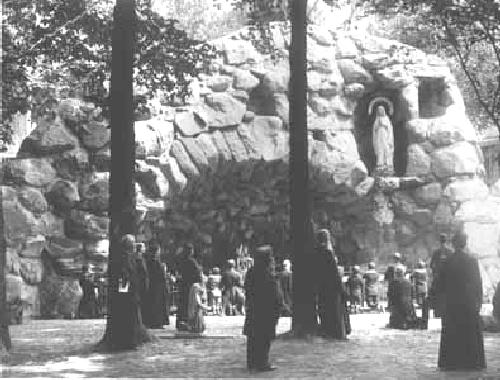
Corby's Favor Granted -- The Dedication of the Grotto
Following are little known facts associated with the actual planning and building of the 1896 Notre Dame Grotto. The Grotto expense ledgers in the University Archives supplied the name of the builder, John Gill. However, the most evidential information on the planning and building of the Grotto, appeared in a small publication no longer in print, the Annals Of Our Lady Of Lourdes.
Copies of this publication are in Rare Books and Special Collections at the Hesburgh Library. The Annals chronicled events associated with Lourdes, France. Volume 1 was published in 1885. In 1949, the last issue, Volume 72, was published. It featured letters regarding cures effected with the use of Lourdes water, here and abroad, as well as articles pertaining to 18th century piety and pilgrimages. It also included the announcement of the building of the Notre Dame Grotto in the spring of 1896
Grotto of Lourdes at the Home of The "Ave Maria,"
Notre Dame, Indiana
For many years it has been the cherished desire of the best and most devoted clients of Our Heavenly Queen to see erected a Grotto of Lourdes at Notre Dame. Indeed several years ago the strongest evidence of this was given. This year new reasons prompt us to action in this holy work. A real fac-simile should be made here at the earliest possible date. Gratitude demands it -- the glory of the Immaculate Virgin demands it. Notre Dame the Home of the Ave Maria, Notre Dame the home of Mary to whom all the grounds are dedicated, to whom all the buildings are dedicated, to whom is given all the credit of the work done here for the past fifty years. Mary is sole superior at Notre Dame and for a thousand other reasons this is the most suitable place in the new world for a real Grotto of Lourdes, and a place of pilgrimages. . . . how can we doubt that a fac-simile of this grotto erected by the piety and devotedness of her children in the new world will fail to please her and cause her to bless every one who contributes to the holy work. Many go all the way to France to visit the grotto and they do well; but many can not go and the next best thing for these is to visit the grotto reproduced at Notre Dame. . . . More particular information will be given later on.(297)
In June, the Annals, described in detail the progress of the Grotto. It verifies the origin and the originator of the 1896 Grotto of Our Lady of Lourdes. It was Father Wm. Corby -- not Father Sorin -- who was inspired to plan and build it:
Grotto of Lourdes at Notre Dame, Indiana
In the last number of the Annals, mention was made of the
Grotto, the facility it would give pilgrims and what a consolation it
would be to those not able to go all the way to France, to come here
and make a pilgrimage at the Grotto of Lourdes. More particulars about
the Grotto were also promised. These we will give now in part. About
a year and a half ago our Provincial, Father Corby, desired a great
favor for the benefit of his Community in the United States. He
started at once for Europe, and after attending to some important
business in Rome, directed his steps to Our Lady of Lourdes, France,
where he celebrated Holy Mass, said some fervent prayers, and then
placed his desired request in the blessed hands of Our Lady of Lourdes.
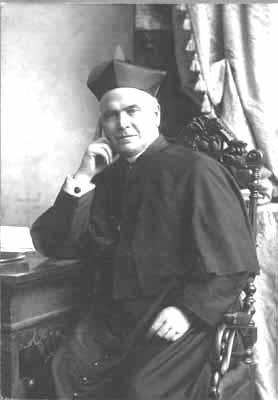 Then and there he promised, with God's help and the help of friends of
Mary, to build at Notre Dame a Grotto in honor of the Immaculate
Conception, if Mary would grant him his request. On the first day of
May, 1895, -- Mary's own Month -- he was informed by cable that his
request was granted. This convinced him that the favor was obtained by
the Immaculate Lady of Lourdes. During the whole year after, he had in
mind the promise he had made to the Blessed Virgin, but a combination
of circumstances prevented him from fulfilling his promise. He
resolved, however, to begin the work this Spring, and late in April,
1896, he wrote a friend in the East to help him build the Grotto.
Strange to say, this friend responded promptly with a handsome
donation, and it came on the Eve of the first day of May, just
as the exercises of the Month of May were about to commence. This he
looked on as an additional proof of Mary's gracious and maternal
kindness. Moreover, it seemed to be a sanction on her part of all that
had been done. First, the spiritual favor was announced as granted on
the first of May; and second, the first generous donation for the
building of the Grotto came on the first of May. This is to
say then on her part, 'You asked a favor of me and I granted it. Now,
I will help you to fulfill your promise, to build me a Grotto, and I
send you on the first of May, -- my own month -- money to enable you to
begin at once.' Mary, evidently, from what we have experienced, wants
a Grotto at Notre Dame. This we see from the simple facts mentioned
above. When in France, at Lourdes, Father Corby was presented, by the
Superior of Lourdes, a model of the Grotto made of metal to
build by. He also brought with him the exact dimensions of the Grotto
at Lourdes, and he intends to reproduce at Notre Dame, a
fac-simile, the exact size of the original. . . . The work on
the foundation of the Grotto has commenced, and we hope to see it
finished by the 15th of August next -- feast of the Assumption.
Letters concerning the Grotto may be addressed either to Rev. W. R.
Connor, C.S.C., or, to Father Corby, C.S.C., Provincial.(298)
Then and there he promised, with God's help and the help of friends of
Mary, to build at Notre Dame a Grotto in honor of the Immaculate
Conception, if Mary would grant him his request. On the first day of
May, 1895, -- Mary's own Month -- he was informed by cable that his
request was granted. This convinced him that the favor was obtained by
the Immaculate Lady of Lourdes. During the whole year after, he had in
mind the promise he had made to the Blessed Virgin, but a combination
of circumstances prevented him from fulfilling his promise. He
resolved, however, to begin the work this Spring, and late in April,
1896, he wrote a friend in the East to help him build the Grotto.
Strange to say, this friend responded promptly with a handsome
donation, and it came on the Eve of the first day of May, just
as the exercises of the Month of May were about to commence. This he
looked on as an additional proof of Mary's gracious and maternal
kindness. Moreover, it seemed to be a sanction on her part of all that
had been done. First, the spiritual favor was announced as granted on
the first of May; and second, the first generous donation for the
building of the Grotto came on the first of May. This is to
say then on her part, 'You asked a favor of me and I granted it. Now,
I will help you to fulfill your promise, to build me a Grotto, and I
send you on the first of May, -- my own month -- money to enable you to
begin at once.' Mary, evidently, from what we have experienced, wants
a Grotto at Notre Dame. This we see from the simple facts mentioned
above. When in France, at Lourdes, Father Corby was presented, by the
Superior of Lourdes, a model of the Grotto made of metal to
build by. He also brought with him the exact dimensions of the Grotto
at Lourdes, and he intends to reproduce at Notre Dame, a
fac-simile, the exact size of the original. . . . The work on
the foundation of the Grotto has commenced, and we hope to see it
finished by the 15th of August next -- feast of the Assumption.
Letters concerning the Grotto may be addressed either to Rev. W. R.
Connor, C.S.C., or, to Father Corby, C.S.C., Provincial.(298)
Father Maguire nears the end of his letter of correction concerning the 1896 Grotto with this brief description of a little known event that occurred as the Grotto was nearing its completion.
The 'spring' actually did appear and old Father Letourneau felt it was a miracle since it appeared almost at the same spot as the one at Lourdes. But wiser people closed it up so as to prevent wild rumors regarding it.
In August another entry appeared in the Annals on the progress of the Grotto which confirms the above excerpt from Father Maguire's letter:
Grotto of Lourdes at Notre Dame, Indiana
We are glad to be able to say that the work on the Grotto at Notre Dame is progressing as well as one could expect under the circumstances. The devoted friends of Mary will be delighted when they come to visit this new shrine of our Blessed Mother . . . . The Grotto will be a thing of beauty and a great incentive to devotion to the Mother of God. We claim no miracles in this work, but we do claim that most remarkable coincidences mark the beginning and progress of this shrine. As has been announced already in the Annals, the first favor asked by the one who started the Grotto was granted on the first day of May, 1895. The second favor was a handsome contribution towards building it, and this came on the first day of May, 1896. Finally, while sinking the foundation the builders struck a beautiful spring of clear cold water in the same spot relatively as the one found in the Grotto at Lourdes, France. The mechanics received orders to open the ground and wall the spring with rocks. To do this they were obliged to use a heavy pump which has a capacity of lifting from twenty-five to thirty gallons a minute. They kept this pump working for five hours before they could reduce the water. As fast as the water was pumped out the spring boiled up in place of the vacuum caused by the pump. These circumstances are given simply for what they are worth, without trying to impose on the credulity of anyone; but the facts remain. In the name of the Blessed Virgin we sincerely thank all who have contributed to this work. The Blessed Virgin knows how to reward her children.(299)
Very early pictures of the Grotto(300) show that an ordinary backyard pump for drinking water marks the spot where the natural spring occurred. It was later covered with the three-sided sculptured drinking fountain now in the same spot at the Grotto.
The Dedication of The Grotto
In September, 1896 the last entry in the Annals describes more fully the occasion of the Grotto's dedication:
Grotto of Lourdes at Notre Dame, Indiana
On August 5th, 1896, the Feast of Our Lady of Snows, a beautiful statue representing the Blessed Virgin as she appeared to Bernadette at Lourdes was set in place in the new Grotto here at Notre Dame. The ceremony of the occasion, though short, partook of a simple grandeur that is not usually seen outside of Catholic countries. In the cool hours of the morning the Religious of the Holy Cross -- priests, brothers and nuns -- to the number of five hundred or more assembled in the spacious College Chapel to assist at Solemn Mass. All who were present approached the Holy Table and, when the services were over, formed in procession leading across the University lawn and through the picturesque grove in which Our Lady's shrine is situated. The brothers were in front carrying the statue and telling their beads, while the acolytes and priests followed with candles and waving banners. The sisters, chaunting the Litany of Loretto and the Magnificat, walked behind the ministers of the Mass. Those who have never witnessed a procession of this kind cannot know the beauty and the glory of it. Hard indeed would be the heart which would not thrill at the sight. To be sure, we do not refer to the mere specular aspect of a number of men and women marching in picturesque habits through a wooded glen, -- though that in itself is something uncommonly striking; we have in mind, rather, the faith of which is hardly any left in our day. No man could gaze on such a scene without feeling in his inmost consciousness -- whatever his outward expression might be -- that in the Catholic Church faith at least is not dead. And when on this occasion, the statue was finally in place and the religious knelt down before Our Lady's image offering prayers of thanksgiving and supplication, it was clear beyond doubt that here at Notre Dame there exists a faith in the Blessed Virgin's power, before God which is as strong and living as that which existed in the very "Ages of Faith" themselves. It is gratifying to be able to say this much, for it means that blessings are in store for the home of the new Grotto as well as the country round about from which the pilgrimages come. When the statue and the Grotto had been blessed, a short sermon was preached by the Very Rev. William Corby, C.S.C., who gave in brief the history of the Grotto from the moment the first donation was received down to its present state of almost final completeness.(301)
An earlier Annals describing the progress of the Grotto reported its planned completion date:
The work on the foundation of the Grotto has commenced, and we hope to see it finished by the 15th of August next -- feast of the Assumption.
However, by coincidence or design, it was dedicated ten days earlier, on August 5, 1896, the Feast of Our Lady of the Snows:
Our Lady of Snows refers to St. Mary Major. This church is so-called because it is the major, the largest, and most illustrious shrine of our Lady in the eternal city. Its ancient name was the Liberian Basilica. It is also known as Our Lady of the Manger, because of its possession of the relics of the Holy Manger. In addition it is called Our Lady of the Snows because of the tradition that the original outline for the church was traced in snow, August 5, 358, after the prayer of a Roman patrician, John, and his wife. Childless, they had promised to make Our Lady heiress of their property, and sought in prayer for some intimation of her will.(302)
Sorin related how he also found that intimation of her will in his description of the departure of the first colony bound for Indiana (Sorin and six Brothers) in 1841. He mentions that departure from France with wonderment:
But on the day of our departure, (August 5, 1841) when I opened my new Breviary for vespers, . . . I was struck to see that we were starting on a beautiful festival day of the Blessed Virgin, Our Lady of Snows. The impression I received from the happy coincidence was not to be soon obliterated. I had absolutely nothing to do with the choice of the day. How often have I not thanked her since, for choosing it Herself, as a proof that she wished us to leave for our new Mission under her maternal protection. To look up to her as to our guiding Star.(303)
The dedication of the 1896 Grotto on the Feast of Our Lady of Snows -- the same day Sorin left France for the New World -- became a second "happy coincidence" for the University. Perhaps, once again, she had chosen for Herself, that date for its dedication, as further reassurance of her offer of inspirational guidance to all those "who look up to her" on the Dome and at the Grotto "as their guiding Star."
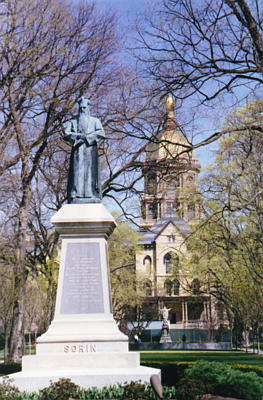
These words from Sorin's Chronicles, aptly describe Sorin's venture in Indiana. A prospect that would have daunted any ordinary man. It is more evidence that Sorin based his whole life and that of the University on the power of persistence and prayer.
With empty hands and empty pockets Sorin had agreed to establish in this wilderness a Catholic University. But with what? With an unshakeable faith that she under whose patronage he had begun this work would somehow and in her own time accomplish it.(304)
Surely the phenomenal growth of the Notre Dame of today is intimation in itself, of the power of the maternal protection of the Mother of Goodness over the past one hundred and fifty four years.
These same sentiments were beautifully expressed in a pamphlet written by Rev. Arthur J. Hope, C.S.C., to commemorate the departure of the Sisters of the Holy Cross at Notre Dame when the convent on the campus closed in 1958. He also wrote, Notre Dame, One Hundred Years, one of the most extensive histories of the University. Regrettably, one of the young students who drowned in St. Joseph Lake was his 22 year old brother. It happened in 1922 when Father Hope was in Rome studying for the priesthood.
Father Hope preached a beautiful sermon at the Farewell Ceremony of the closing of the convent in which he expressed the University's appreciation for their loyal and devoted motherly service to the campus. He recalls "when the Sisters first set foot on this land of the Blessed Lady, of their devotion to the priest who had begun all this . . . who had fashioned this University in the wilderness." He speaks of that same priest being lovingly attended by those same Sisters when he lay dying in the presbytery:
He was leaving it now -- crowned with a shining dome and the golden lady -- who had been his Life, his Sweetness and his Hope, for whom he had named his work. . . . With him in his last moments were his lifelong companions, the Sisters, to ease his painful weakness -- to wipe his brow and moisten his lips -- to give courage to his thoughts.(306)
Mother Ascension, who was devoted heart and soul to the interests of Father Sorin and Notre Dame, was with him. So was Father John W. Cavanaugh, who describes his last moments:
I remember seeing Father Sorin as he lay dying in his own bedroom attached to his suite on the first floor of the Presbytery. He was breathing heavily. His cheeks glowing with each recurring breath. There was little change in his aspect except that his eyes moved furtively about the room up and down and towards the side almost constantly. At the same time, I noticed that very frequently, even in his unconscious condition his gaze erected for a moment on the pretty little statue of the Blessed Virgin which had been set upon a small table at the foot of his bed. Those in the room were the venerable Mother Ascension, who had been such a true friend and helper to Sorin, Brother Columba, his faithful nurse during the months and years even of his illness, a little novice who was there to be useful in whatever way she could, and Father Zahm who held Father Sorin, literally in his arms, as he breathed his last.(305)
How pleased Father Sorin would have been had he known that in three more years there would be another tribute to his golden lady -- just a stone's throw away from where he lay dying -- the present 1896 Our Lady of Lourdes Grotto at Notre Dame.
Nor could Father Sorin, or Father Hope, have foreseen the plans Our
Lady had for the future of the University they called their home. In
1958, coincidentally the 100th anniversary of the Lourdes Grotto in
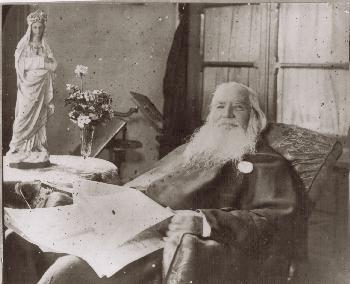 France, Father Hope concluded his farewell sermon to the departing
Sisters with his own prophetic views about the future growth of the
University:
France, Father Hope concluded his farewell sermon to the departing
Sisters with his own prophetic views about the future growth of the
University:
Will Notre Dame prosper in the future as it has in the past? It has leaped from obscurity to renown; it has passed through fire and pestilence to prosperity and influence; from a meager beginning, it seems to have had a marvelous flowering.(306)
How aptly his words apply to the University of today as it continues to blossom and grow beyond anything its founder would have ever been able to imagine. Were Sorin here to see it, I am sure, to him, it would merely show yet more clearly the hand of God in the direction of human events -- whether they be fortune or misfortune.
Timothy Howard speaks of the Sorin he knew in his later years:
The richest of all the gifts received by Fr. Sorin on this solemn Jubilee feast (1888) is that which Fr. Sorin has himself given to religion -- his own life. And this gift, like the grain of mustard, has grown, flourished, and sent forth leaf, bud, blossom, and fruit, until Notre Dame today is among the fairest of all the beautiful gardens planted in the wilderness of America.
The snows were now transferred to his noble brow, to his flowing beard, both worthy to adorn a prophet's head. Only the dark eye of genius, only the strong mental grasp, the immortal youthful hope and the childlike faith, marked him as the same courageous and far-seeing priest that had planted the cross in the wilderness, and beside the cross built up this dwelling place of religion, art and science.(307)
On October 31, 1893, Allhallow eve, "eve of all the holy ones' day" in the wake of declining health; Very Rev. Edward Sorin, C.S.C., founding father of the University of Notre Dame, took his last breath on earth. The University prepared for his funeral on All Saints' Day and he was buried on All Souls' Day. In his Chronicles, Sorin had noted with wonder the significance of his departure from France to "this new world" on the Feast Day of Our Lady of Snows in 1841. He would have been equally pleased that he departed from this life under similar significant circumstances.
In Notre Dame One Hundred Years, the author, Father Hope describes his funeral:
Archbishop Elder of Cincinnati preached the sermon. His words were a great comfort. He very likely exaggerated a bit when he said he did not 'think that in all our country, nor in any single country, there is a place where one single man has transformed a savage wilderness into such a city of splendor and culture as this University of Notre Dame' he found a vibrant response in the hearts of his listeners. He made the most of the fact, also, that Father Sorin's death had occurred on the last day of October, a touching symbol, he said, of Father Sorin's two great devotions -- his confidence in the Blessed Mother to whom October is dedicated, and to the Poor Souls, for it was the eve of November that he had died.
. . . when all was ready the coffin was lowered into the grave. Only the autumn leaves, brown and rustling, whispered in the silence. He would have been eighty, they said, had he lived until spring. He was so great a man that no one, on that occasion, cared to think of his shortcomings.(308)
It would not be an exaggeration to conclude, that Notre Dame might not exist today without the distinctive personality and character of its founder and his unwavering faith in Mary. To the end, Father Sorin's whole being was focused on the Blessed Virgin. Notre Dame du Lac was everything to him because Our Lady -- the Mother of Goodness -- was everything to him. He was a man with a mission -- the keeper of the flame of her faith.
When Father Sorin died that flame was passed on to Rev. William Corby, former Chaplain of the Irish Brigade during the Civil War. A statue depicting him giving general absolution to soldiers going into battle at Gettysburg stands in front of Corby Hall on campus. A soldier after the war told his wife, "he felt as strong as a lion after that and felt no fear although his comrade was shot down beside him."(309)
The influence of Father Sorin's penchant for doing everything bigger and better has not been wasted on his successors. Each in his own way has carried on that tradition. Sorin was never one to do anything half way. He was always topping himself in honoring Our Lady. First the small bell was replaced with a huge one, the organ with a much finer one, the first church and main buildings with bigger and better ones; and the Dome and its statue of Our Lady, with even larger versions.
The first statue, representing the Blessed Virgin as she appeared to Bernadette at Lourdes, which was placed in the newly completed 1896 Grotto was the same statue that had adorned the octagonal glass enclosed tower-like niche of Father Sorin's earlier Grotto built in 1878 before it was removed. A halo with the wording, "I AM THE IMMACULATE CONCEPTION" was above it as they appear over the statue at Lourdes.
How pleased Father Sorin would have been had he known that Father William Corby was about to carry on that tradition in building a bigger and better Grotto at Notre Dame; one that has so surpassed Sorin's first Grotto that it has been literally forgotten. Although Father Corby accomplished what Father Sorin wasn't able to achieve, nonetheless, Sorin's silent influence was as responsible for the Grotto being there as if he had been on the scene, as he surely must have been, in spirit.
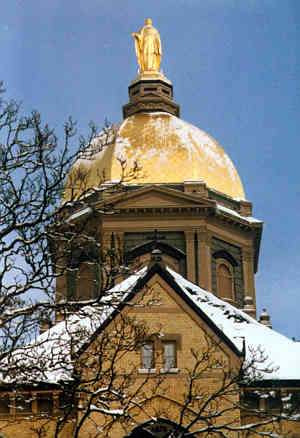
Father Sorin may be gone, but the light of faith Our Lady instilled in him is burning ever brightly in the candles at her Grotto. The spirit of her faith sustained him as it has the power to sustain all those at the University who wander, by accident or design, into her presence on the Dome and at the Grotto.